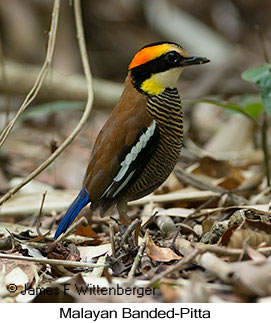ABOUT OUR CHECKLISTS


The checklists on our website are intended as a source of information for researching our site visitors' birding tours. The data has been gathered from numerous public sources as well as tours we have conducted. With well over a quarter million records in our database, it's difficult to maintain full accuracy or complete consistency. We have gone to great lengths to ensure species on our checklists are actually present where we list them. Lists of endemic and near endemic species should be quite accurate, and we update IUCN status occasionally to keep those settings reasonably current. Lists of range restricted and locally distributed species are less objective and our criteria for those will be elaborated below. Lists of target species are very subjective and will also be elaborated below.
ABOUT RANGE RESTRICTED & LOCAL SPECIES DISTRIBUTION
The concept of restricted range is quite subjective. The typical definition is that a species has a restricted range if it's global extent is less than 50,000 SqKm. We refer to this concept as globally restricted range, which differs from the usage on this website. For our purposes, restricted range refers to a species distribution within a particular country. Thus a species can be listed as restricted in range on our checklists for a country even when it is widely distributed elsewhere.
Previously, we treated species as having a restricted range when the extent of its presence in a country was geographically limited. However, we have found that this concept is not especially useful and is too broad of a definition. Thus, we now consider a species as having a restricted range only when it's range is restricted within the altitudinal zone or general habitat type where it normally occurs. For example
, if a species is found in a narrow altitudinal zone in the Andes Mountains but is present throughout much or most of that altitudinal zone in the country, we do not consider it's range to be restricted. Similarly, if a species is found only in arid regions, it's range is not restricted if it's present in much of the arid region in a country, even if the extent of that region is quite limited in that country. This can be very confusing, as a range map may suggest the species is range restricted when we don't treat it that way. For instance, only a small part of southern Brazil is pampas, and species in that habitat may seem to be range restricted. However, they are everywhere in the pampas, so their range is not restricted within habitat suitable for the species even though their geographical range only includes a small part of southern Brazil. On the other hand, we do treat species restricted to the small amount of savanna in far northern Brazil as range restricted even though there is extensive savanna farther south. They just can't get there because the Amazon basin acts as a barrier to expansion.In addition, we generally exclude seabirds, gulls, terns, and the like from our lists of restricted range species. We also generally exclude passage migrants even if they might only cross a small part of a country for the simple reason that they're not readily found during a birding tour unless the timing is just right.
The concept of local distribution is also a bit nebulous. Some authors treat a species as locally distributed if it's in a very small location in a country and nowhere else. Similarly, a species is often considered locally distributed if it's habitat is patchy. This latter definition is dependent on just how micro the scale of habitat suitability is used to define patchiness. Sometimes, a species is considered to be local when actually it is just very scarce, making it appear like lots of suitable habitat is unoccupied. For present purposes, we consider a species locally distributed if it is more or less widely distributed in suitable habitat through much of the country but is only found at scattered locales within that apparently suitable habitat type. We also consider it local if there is one or more very small scatterd populations in the country. We do not consider a species to be locally distributed just because it's scarce, though scarce species can be locally distributed if individuals or pairs tend to be clumped together in scattered locales throughout apparently suitable habitat. We also do not consider a species as locally distributed if their abundance is described as locally common. It's a bit difficult to decide sometimes whether a species is locally distributed or not due to lack of adequate data, so a classification as local is sometimes rather subjective.
ABOUT TARGET SPECIES
Target species are those that one especially wants to see on a given tour. This has much to do with both personal preference and what a person has seen or not seen before. When on tour, guides will often target highly desirable species in a particular locale. The species may be in many other locales visited on the tour, but the guide looks in a particular place because the species is easier to see there, the species is more common or more reliable there, or the guide has had his best luck seeing the species there before. Sometimes, finding a bird depends on very local knowledge, meaning the guide knows where a particular individual's territory is. For this reason, target lists for locales visited on a tour don't really make a lot of sense. This fact became evident when we updated the species lists on our website. With more complete lists for each locale, we found that for the vast majority of species, desirable species are actually listed in many locales. However, commonness can vary greatly between locales or from year to year, and the absence of such data at many sites makes it impractical to provide useful target species list for particular locales.
For the above reasons, we have modified our target species lists. We first identify target species for a country. These target lists are birds best seen in that country becuase they are endemic or near endemic to that country or the country is the best place to see the species because it is only found in remote parts of other countries or other countries are not accessible for birding due to political reasons. We should note that we don't have data for all countries, so sometimes a species is listed as a target even though it can be readily seen in other countries for which we don't have data. Below are the criteria we used to identify target species:
First, all endemic and near endemic species are included on the list for the obvious reason that the species can only be seen in one or two countries and not everybody will visit both countries.
Second, we include all species listed by the IUCN as critically endangered or endangered due to the simple fact that the populations and/or ranges of these species are much reduced.
Third, we include species on a target list if the species is found at locales in that country visited by typical tour itineraries nad is only found in remote places or locales rarely visited by birding tours in all other countries where the species is found for which we have data.
Fourth, some species are just plain desirable to see. An example that comes to mind is Resplendent Quetzal, which is found in several countries in Central America and hence is not a near endemic but is such a great bird that everybody wants to see it.
Finally, we do NOT include restricted range species on our target bird lists if the bird is widely distributed in other countries or if the bird's range is only in remote areas. These birds are listed on our specialty birds lists. We do not include birds found exclusively in remote areas of a country unless they are endemics or near endemics. We do not include nomadic species because their location at any given time is somewhat unpredictable, making them difficult to target. We exclude accidentals and vagrants for obvious reasons. Finally, we do not include North American or European migrants wintering in the Neotropics or Africa because our clients can generally see these species in their home countires.
Using the above criteria, our software generates a list of target species for each country using our extensive database. The software then creates target lists for each birding locale in the country as a subset of target species for the country that occur in that locale. It should be noted that in many cases we lack data on commoness or rarity of species in those locales. Hence, a species may be included as a target for the locale even though it is rare. We do exclude species that we know are very rare from those lists.





